During the 1846-1847 Highland Potato Famine, the construction of the road from the Corrieshalloch Gorge to Little Loch Broom employed starving crofters in exchange for oats. It became known as ‘Destitution Road’.
Today, it’s called the A832 and is part of Scotland’s North Coast 500 route. More to the point, as it swings north-west across open moorland from Braemore Junction, it treats travellers to a view of what is arguably Great Britain’s greatest mountain: An Teallach.
Like Glen Coe’s Aonach Eagach or Torridon’s Liathach, An Teallach is a mountain massif consisting of multiple summits, including two Munros. It’s oft mentioned in the same breath as “the most spectacular ridge traverse on mainland Britain”. And yet in a recent poll of the best Scottish mountain walks, An Teallach barely registered.
Its name translates as ‘The Anvil’ or ‘The Forge’. On days when its rocky talons claw at leaden clouds, it’s easy to picture it as the lair of some demon blacksmith brutishly hammering lost souls into oblivion. The briefest of Googles reveals talk of “Scotland’s most challenging mountains” and “plucking up courage”. Little wonder that An Teallach is rarely regarded as a walk. But as Trail recently discovered, it most definitely is.
For a detailed route guide, check out how to scramble An Teallach.
King in the North
A huge mountain day
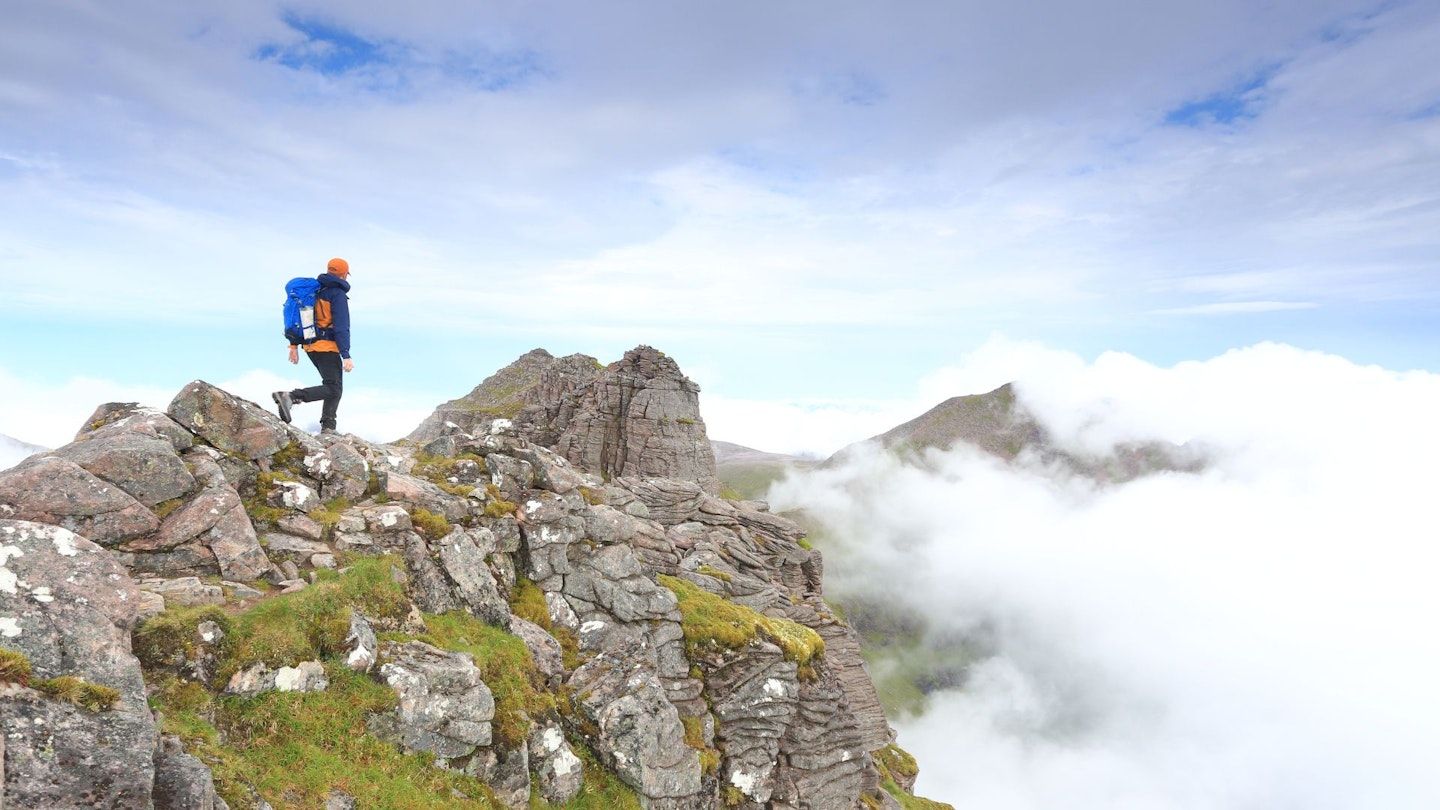
We set off at 5.30am, prompted by a deteriorating weather forecast of afternoon cloud and lightning. An Teallach is such a visually striking mountain that being able to see it is a must. Plus, we didn’t want to be a kilometre up during a thunderstorm.
The previous evening we’d gone on a recce, walking up the track from Corrie Hallie before breaking off to cross the Allt Gleann Chaorachain and ascend above Coire a’ Ghiubhsachain on a mix of rough heather and grey quartzite pavement. This pavement is part of a vast ribbon of Quartz-arenite that stretches from Loch Eriboll on the north coast to Loch Carron on the west.
The bulk of An Teallach is formed of Torridonian Sandstone, but at the base of the mountain’s eastern flank an exposed escarpment of quartz over 5km long rises sheer faced from Coire a’ Ghiubhsachain. It has the air of a vast defensive wall carved millennia ago to defend against some ferocious multitude. Orcs, perhaps.
It’s possible to traverse the escarpment on the walk to An Teallach – a journey that delivers tantalising views of the intimate intricacies of the mountain above – but adds time and effort to an already big day. In the early hours we instead stuck to the track from Corrie Hallie, through Gleann Chaorachain, and to its highpoint above the remote Loch Coire Chaorachain.
Steep and pathless
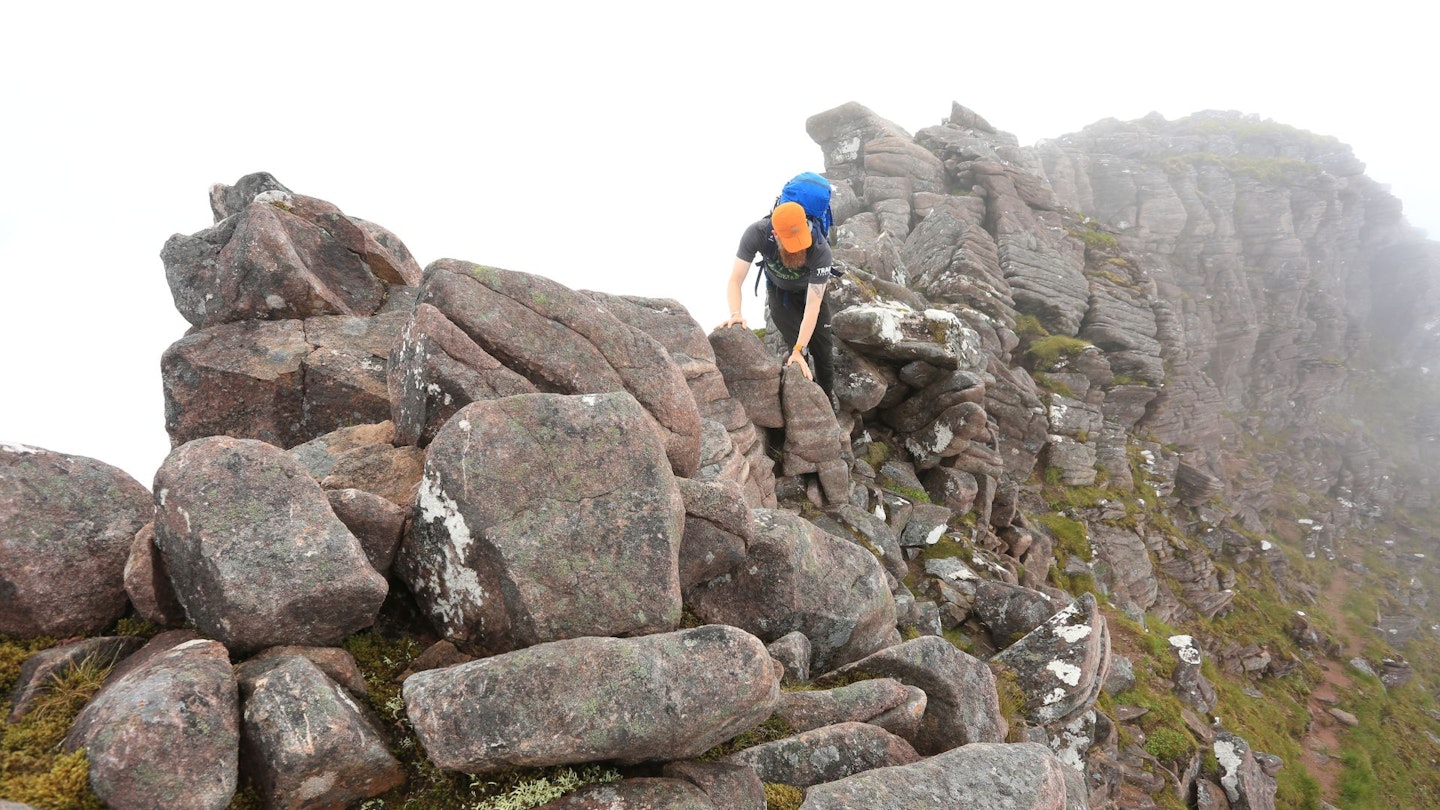
Forking right, we departed the main track to begin the ascent of Sàil Liath. Low cairns signposted the way as the gradient steepened and the path began to snake across the broad hillside. But as the higher boulder-covered ground was reached, any trace of a path all but disappeared.
We made our own way through the awkward mix of lichen-coated rock and grasping heather. At the point of wondering if the mountain would ever relent, it did. The slope began to round, and the final kilometre to Sàil Liath’s summit was over gently rising ground, accompanied by a curious, but not particularly brave, tribe of feral goats.
An Teallach is perched on the northern extremities of the Fisherfield Forest in an area known as ‘The Great Wilderness’. There’s nothing there – nothing except rolling moorland and glorious craggy-topped peaks, interspersed with twisting rivers and deep-watered lochs.
On the opposite side of Loch na Sealga the twin summits of Beinn Dearg Mor and Beinn Dearg Beag sowed the seeds of future adventures. For the time being though, our concentration was focused on the continuation of An Teallach to the north. The perspective was foreshortened from our viewpoint, but the serrated edges and precipitous pinnacles were unmistakable. Anticipation was growing.
Sail Liath’s summit is covered by the same pale quartzite as the escarpment. But here, 954m above sea-level, the jackhammer of the weather has shattered the stone into jagged pieces. The descent towards the bealach linking to Stob Cadha Gobhlach brought a more distinct contrast, the light greys giving way to deep reds and the sharp edges of the quartzite replaced by the rounded curves of sandstone. The curtain was being pulled back on An Teallach’s true nature.
An extravagance of rock
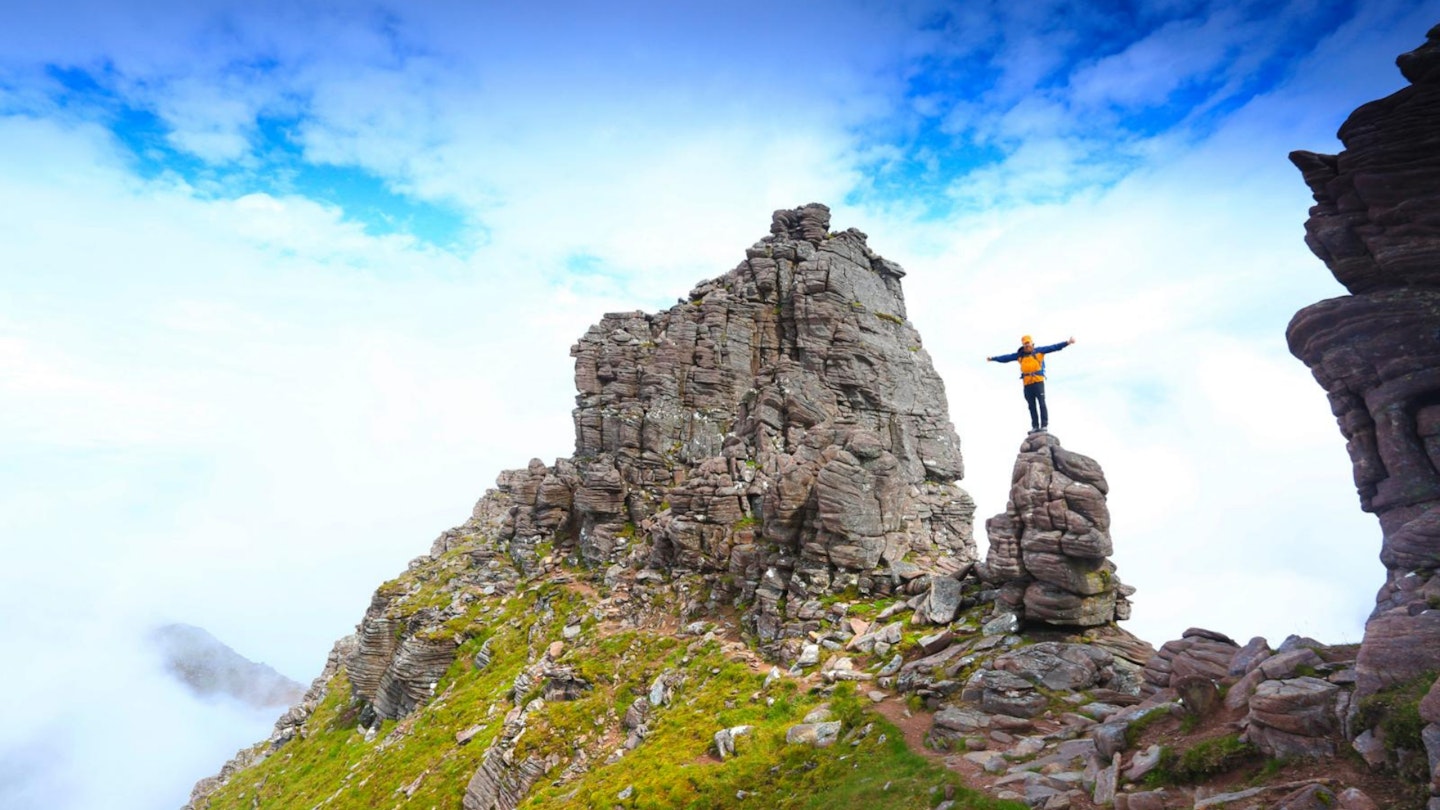
Corrag Bhuidhe is where things start to get serious. From Stob Cadha Gobhlach there’s another bealach to cross, and the first half of the following ascent is more of the same reddish earth and rounded rock. Then with little warning the way is blocked with almost Gandalf-like deliberateness. A buttress of rippling sandstone rises up where the path should flow. This is An Teallach’s ‘Bad Step’, and it leaves just two onward options to reach the pinnacles beyond…
Option 1: Tackle the Bad Step – a considerable undertaking. The rounded sandstone is frictionful but with a sparsity of positive holds. It’s the most difficult obstacle on the traverse, and not worthy of consideration unless you’re confident soloing Grade 3 scrambles, have an excellent capacity to cope with exposure, and are handy with a rope. But this is where An Teallach reveals the ace up its sleeve, and it’s a card that’s played more than once.
Option 2: The bypass. Slipping coyly away to the left, a narrow path winds around the Bad Step and begins a parallel but significantly less fierce ascent towards the ridge above. And the best news is that this get-out option remains for pretty much the entire ridge. It’s not a route to be taken lightly; it is thin, eroded, and traverses some exposed slopes.
But for less than ideal weather, those not confident with scrambling, or scramblers wanting to pick and choose what they scramble, it opens up a mountain that would otherwise be the reserve of mountaineers. It is this that makes a traverse of An Teallach entirely walkable.
Attacking the ridge
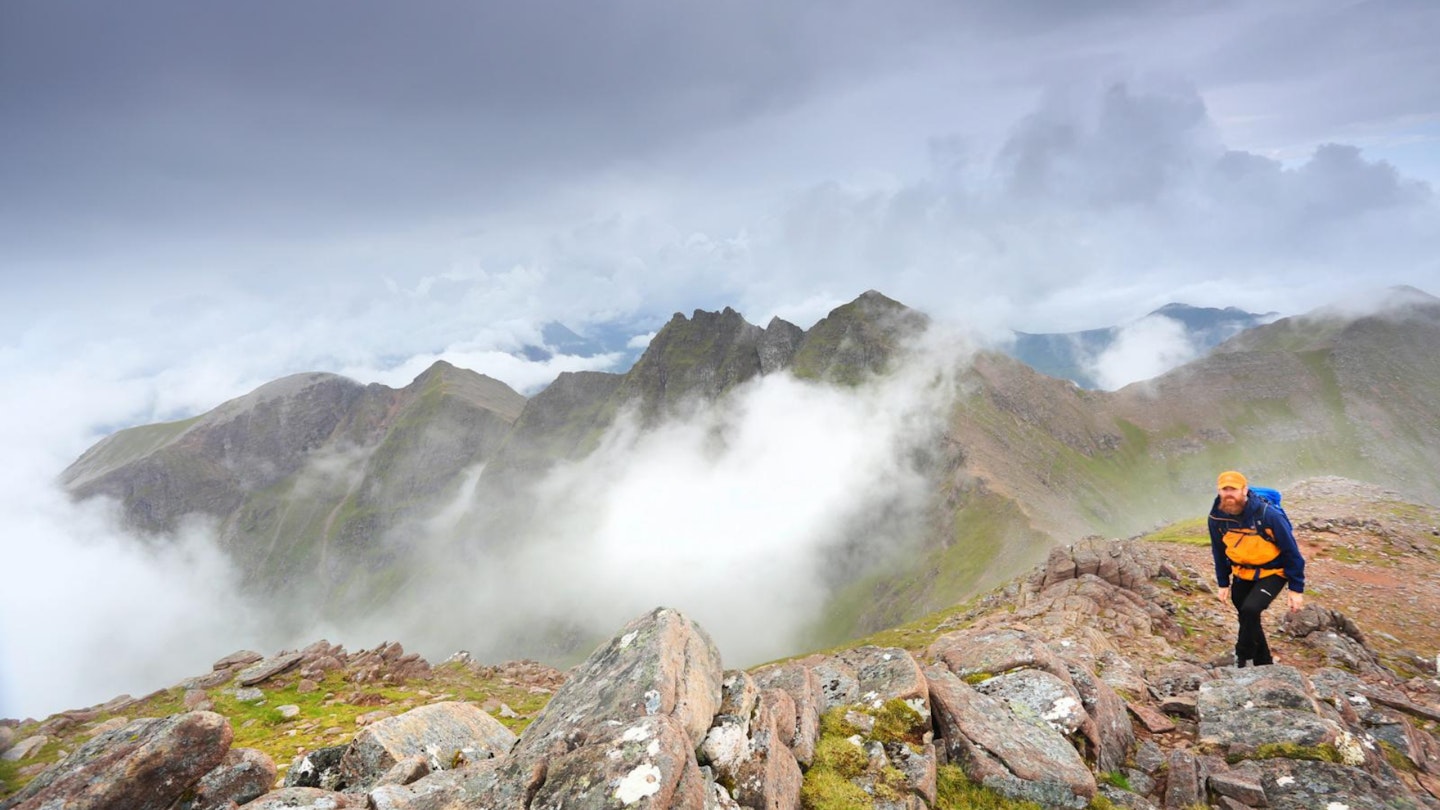
Beyond the top of Corrag Bhuidhe, the path re-joins the main ridge for An Teallach’s most celebrated, inspired, and infamous stretch of mountain. Here, the arête becomes more focused in every respect, narrowing to Sharp Edge-like acuteness.
A near-continuous chain of exposed sandstone spine irregularly punctuated by pinnacles, for most of this section anyone with a tolerance for heights will be content to saunter along the top, watching their feet and enjoying the expansive views into the magnificent Toll an Lochan far below. And if an obstacle proves a challenge too far, that bypass path remains a constant companion just down to the left.
Thanks to our early start the weather was still benign, although drifts of cloud billowed up and over the ridge. Each and every sandstone turret was climbed – not as an act of machismo or bravado, but because this just might be the best slice of mountain anywhere in the UK, and we wanted to experience every inch condensed into this half-a-kilometre of ridge perfection.
Then, abruptly, the pinnacle scrambling came to a stop. Just ahead, rising out of the ridge, a toppling spear-head of sandstone leaned out over the abyss.
Scotland's scariest seat
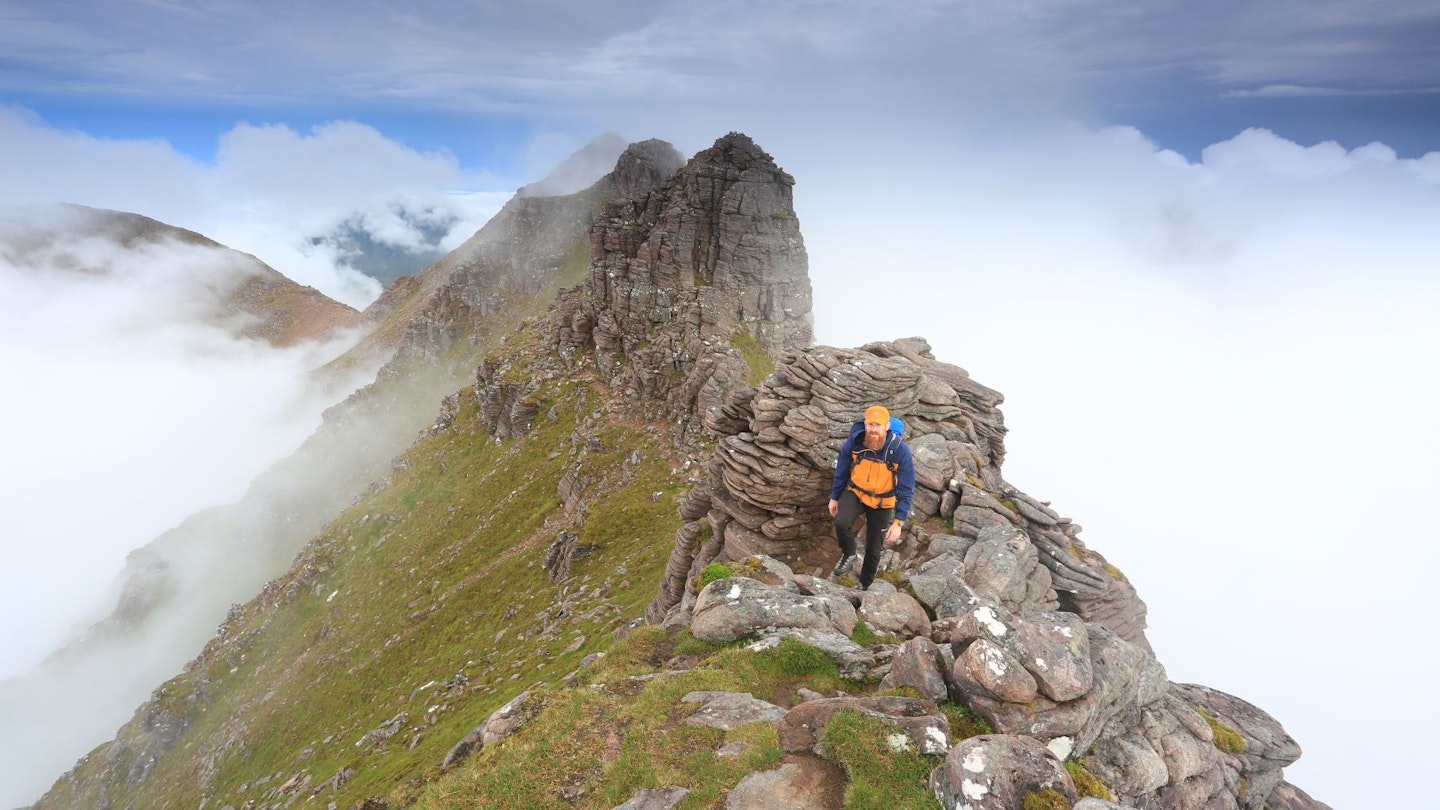
Sir Hugh Munro is said to have described Lord Berkley’s seat as “a pretty little rock tooth”. Sir Hugh Munro must have had one dram too many. ‘Stonking mammoth rock tusk’ would be more accurate. Our clamber up it was none too taxing, but at its top, the familiar jumbles of rounded rough sandstone… just… stopped.
With some prompting I bumshuffled toward the edge and dangled my legs over, watching the fog swirl around them. When the mist finally cleared, I would have given anything to not be sitting where I was. Below was nothing but empty space, and then, some distance away, the ground. The fact that Lord Berkley’s seat is a) overhanging so you can’t see what’s supporting you, and b) slightly sloped towards the drop is enough to make the experience desperately unnerving.
I was no more likely to fall from it than I would from a dining chair, but that drop… I called out to Trail photographer Tom to hurry up and take his bloody pictures because, to be blunt, I’d quite like to get the hell down. Except I didn’t. The words stuck in my throat and all that came out was a small, rasping, terrified squeak. I decided that, photos or no photos, Lord Berkley could have his seat back.
Munro bagging
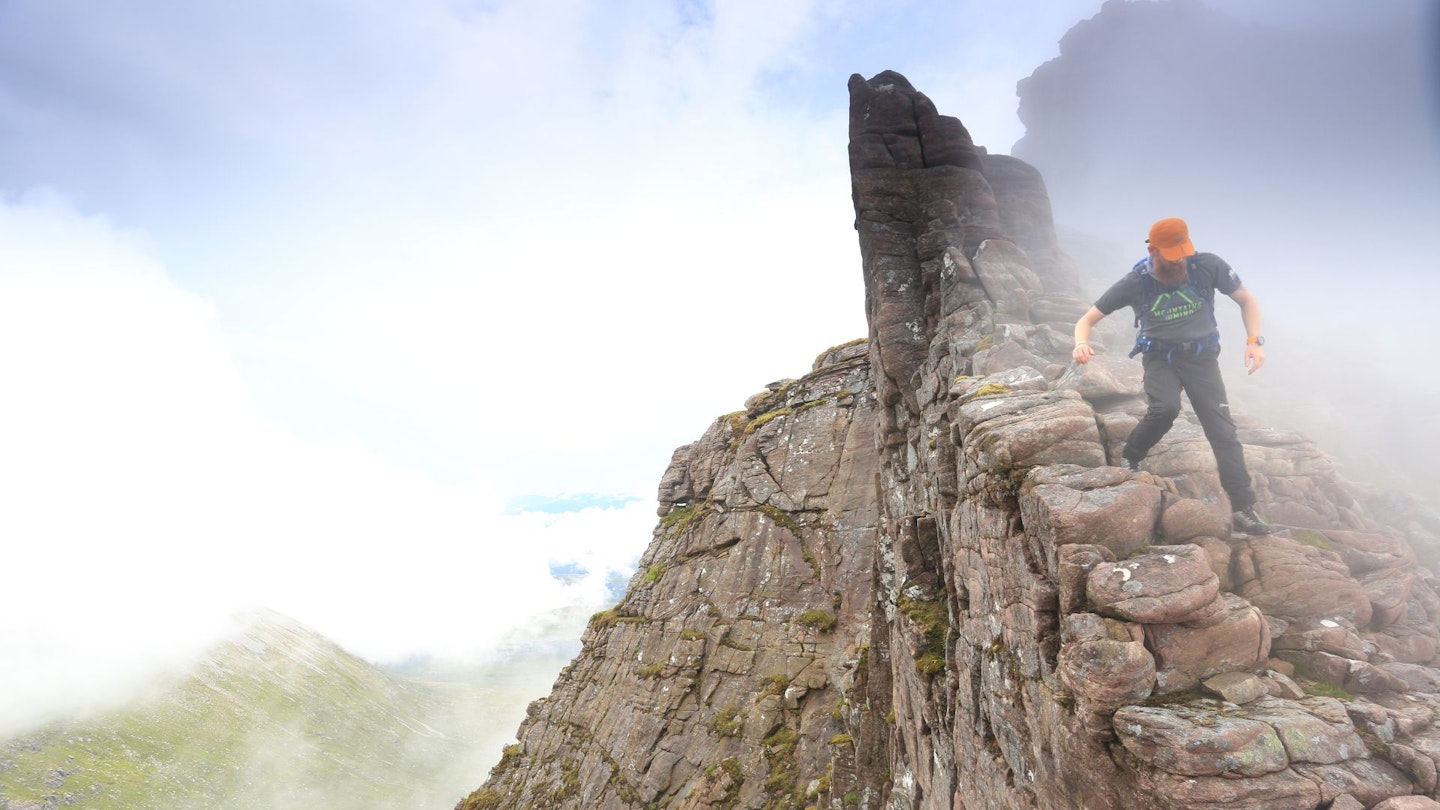
This marked the end of the scrambling and we re-joined the path for the short ascent to Sgùrr Fiona. If traversing the ridge from south to north (it can be done in either direction, but route-finding challenges are lessened starting from the south), its summit marks the highest spot of the ridge so far. It’s the first of An Teallach’s two Munros, but it wasn’t always the case.
Until 1981, Sgùrr Fiona (1060m) was but a subsidiary peak of An Teallach’s highest summit, Bidien a’ Ghlas Thuill (1062m). The Scottish Mountaineering Club promoted it to Munro status on the basis that its prominence of 142m was enough to identify it as a separate peak from its northern neighbour. Not everyone agreed, but when Sgùrr Fiona’s other physical attributes are considered, it more than deserves such recognition.
A tri-faced, fine-pointed pyramid, Sgùrr Fiona’s ridges lead south to the pinnacles, west along a lofty arête to Sgùrr Creag an Eich (a rarely visited satellite of An Teallach) and north as a continuation of the main massif. It is a handsome peak; more aesthetically appealing than Bidien a’ Ghlas Thuill, which, by comparison, is unrefined. But as we discovered when the cloud parted once more in a final gesture of benevolence, it has one very special advantage. Nowhere else on the mountain do you get such a comprehensive panorama of the entire massif.
Sweeping from left to right, the journey from Sàil Liath, over Stob Cadha Gobhlach, the clamber to the Bad Step and Corrag Bhuidhe, the frenetic skyline of the An Teallach Pinnacles, Lord Berkeley’s Seat, the triangular profile of Sgùrr Fiona and the long, red saddle linking it to Bidien a’ Ghlas Thuill can all be traced with an outstretched finger.
Scotland's finest?
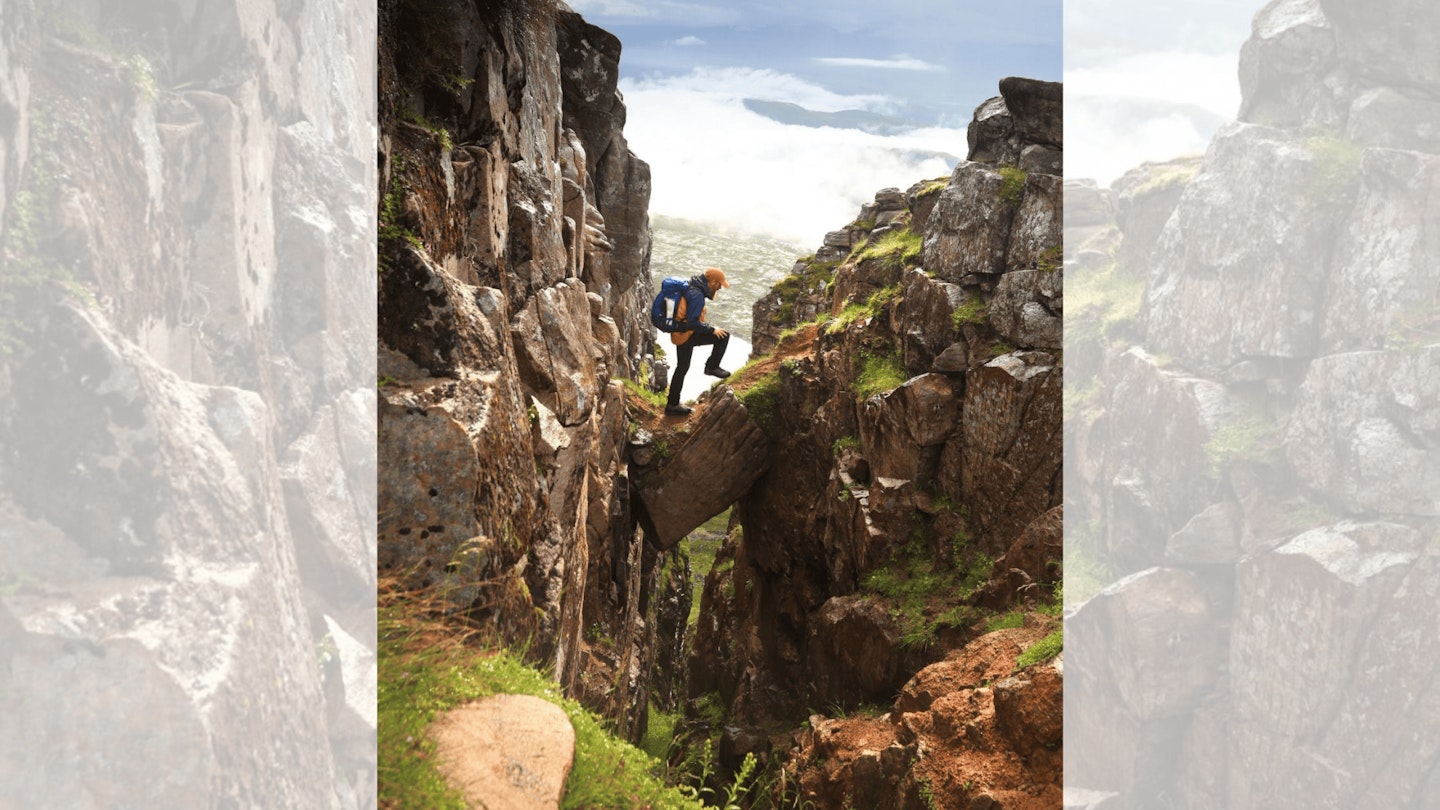
When the top of a mountain is as thrillpacked as An Teallach, the walk out will always be a bit of a come down. Before too long the road was in sight and, not long after, we were at the car park in Dundonnell. However, the car was at Corrie Hallie, a 4km walk away along the unforgiving tarmac. ‘Desolation Road’ indeed. But we’d prepped for this, leaving a bike chained up ready to provide a less demoralising way back. For one of us at least…
While Tom pedalled off to ‘bring the car around’, I spent the half-hour it would take him sitting in The Broomeg Bar of the Dundonnell Hotel mulling over the key questions of the day: Is An Teallach Scotland’s best mountain? And is it really for walkers? The answers I arrived at were ‘probably’, and ‘yes’.
Yes, there’s scrambling to be found; yes, there are challenges to be tackled; yes, there are sheer, overhanging drops that make you fear for the cleanliness of your merino underwear. But your exposure to these elements is, for the most part, within your control – it’s possible to walk the entire thing end to end without setting hand or foot on a scramble.
So, whether you’ve never considered An Teallach as a destination for the humble walker, or simply never even considered An Teallach at all, you really should. It’s about as good as it gets.
Tempted now? Read our step-by-step guide on how to scramble An Teallach.
Six other contenders for Scotland's greatest hillwalks
Contender No. 1: Ben More Coigach
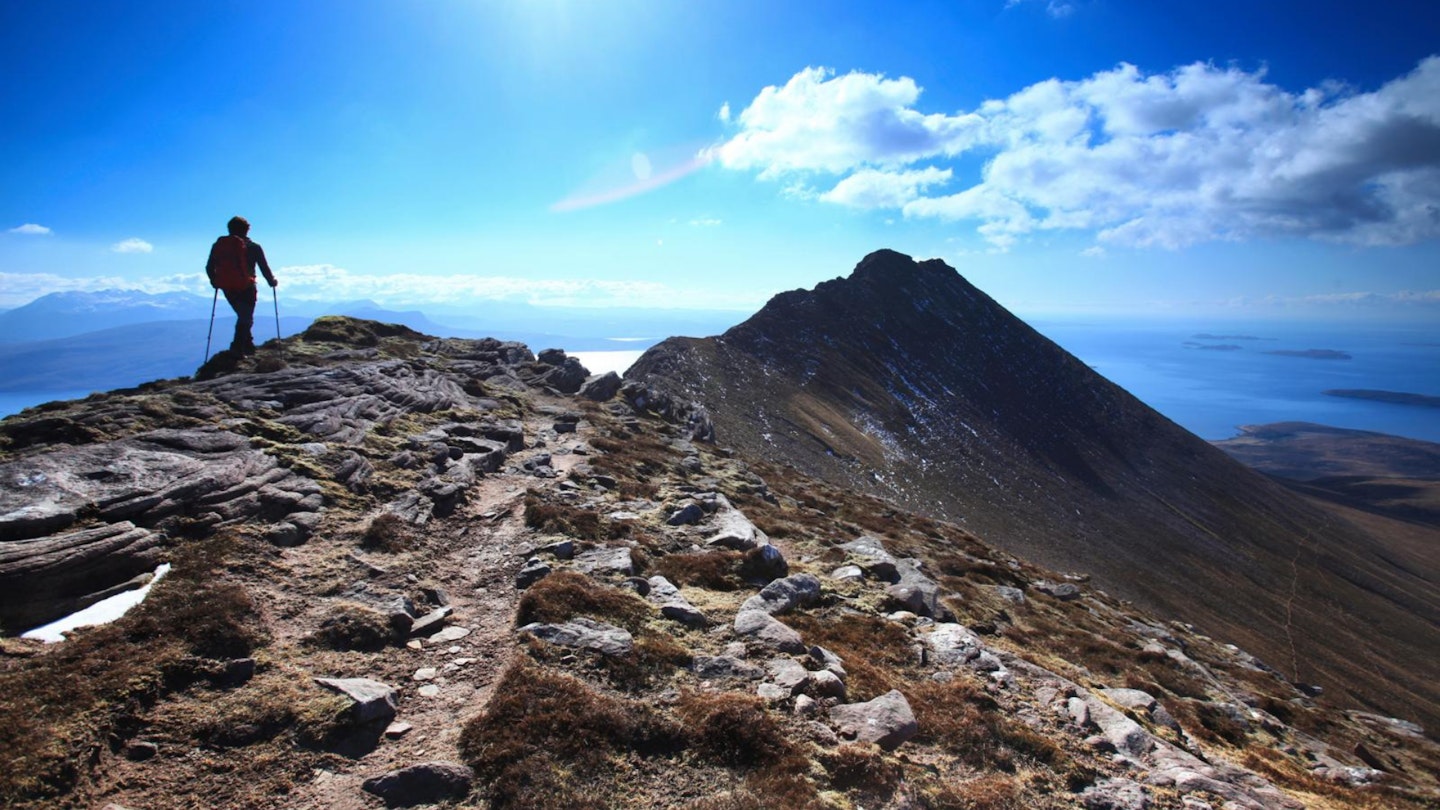
Another mountain from Scotland’s far north-west, Ben Mor Coigach is a more complex beast than its monolithic Assynt neighbours. With its western flanks dipping in the sea, the mountain feels much higher than it should, while the various ridgelines, subsidiary peaks and wide-open coires provide plenty of opportunity for exploration.
And if you’re looking for a good place to get great views of the Assynt peaks, there’s nowhere better.
Contender No. 2: Buachaille Etive Mor
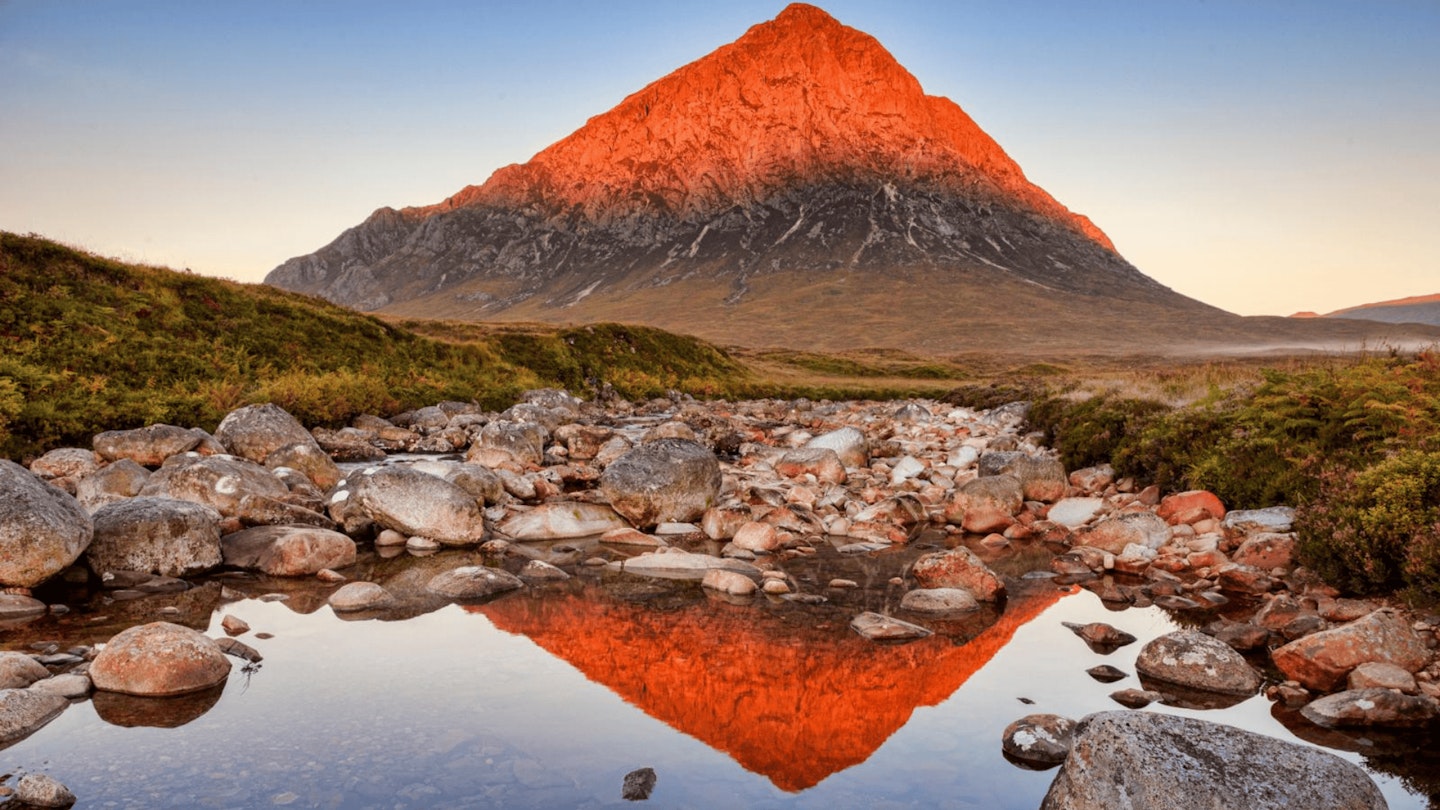
One of the most photographed mountains on the planet, Buachaille Etive Mor translates as the Great Herdsman of Etive. But what is it herding? Sheep? Other mountains? Haggis? Or people to its summit?
The truth is, once you’ve seen it from below, it’ll have its crook on you and you won’t be happy until you’ve stood on top and soaked up every last inch of the view over Rannoch Moor and into Glen Coe. An absolute must.
Contender No. 3: The CMD Arete
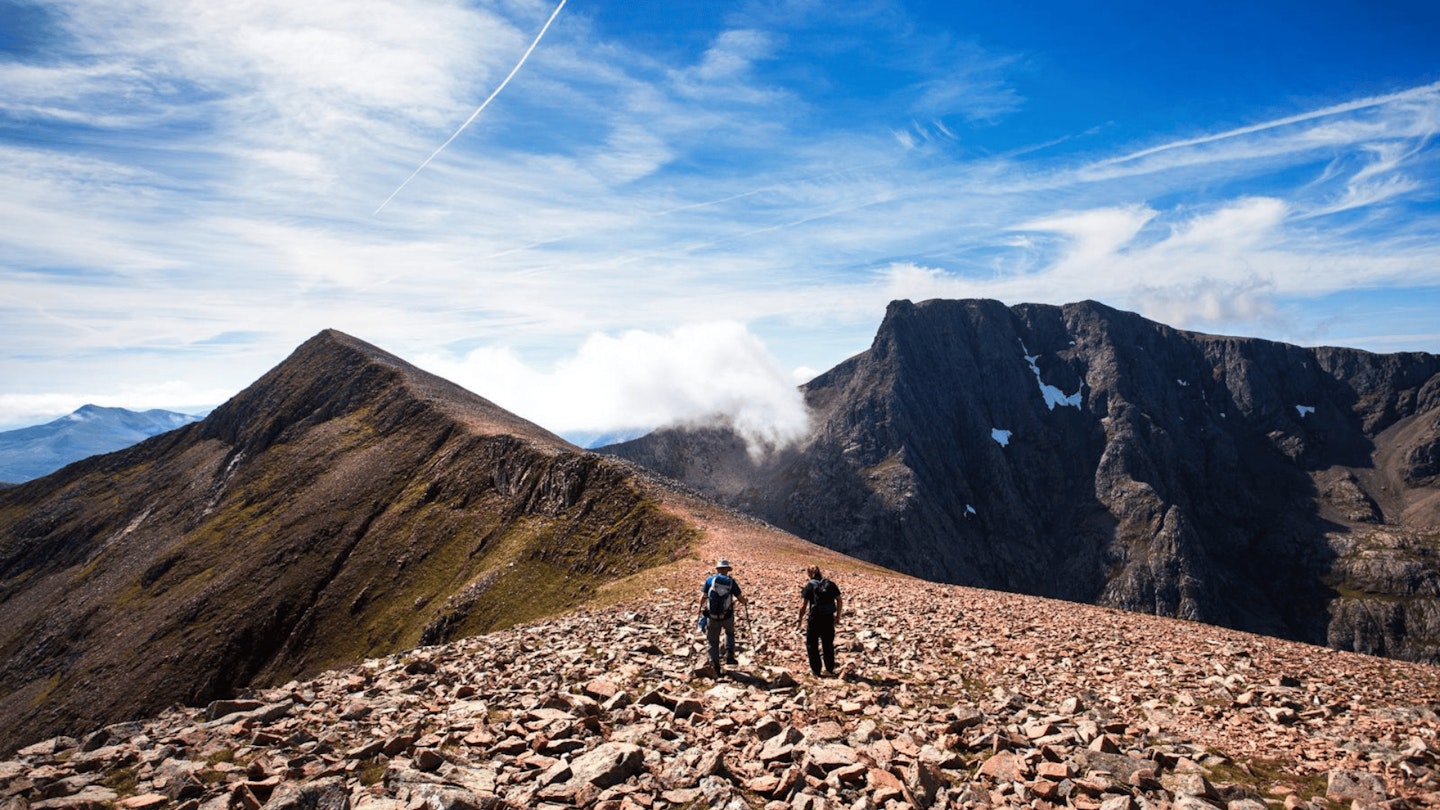
While height isn’t everything, at some point you have to stand on top of the big one: Ben Nevis. And if you’re going up Ben Nevis, the CMD arête is the way to go.
Narrow enough to be addictively exciting but not requiring anything more than adventurous walking, the arête presents a phenomenal view of The Ben’s rugged North Face before elevating you to the highest ground in the British Isles.
Contender No. 4: Suilven
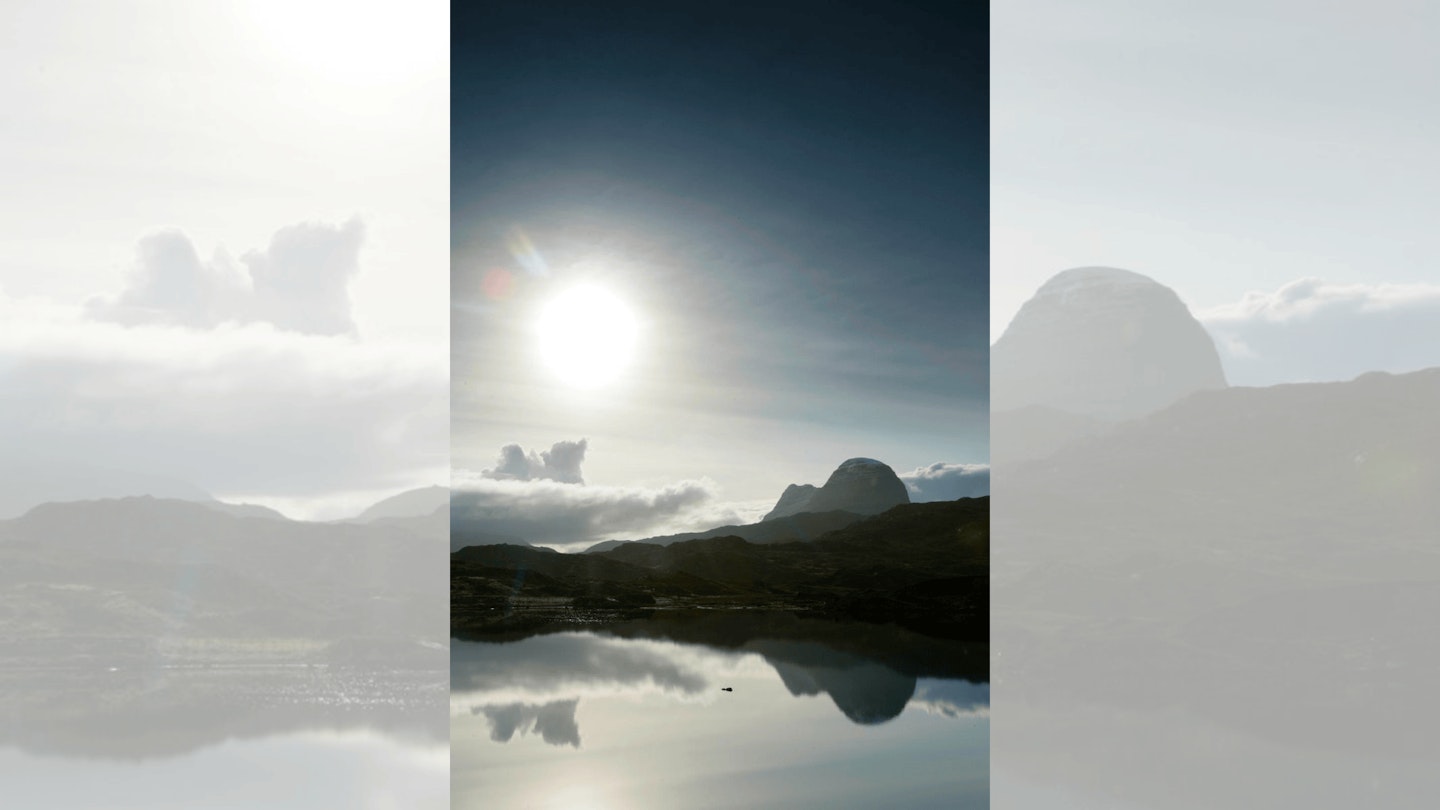
Perhaps the most iconic of the cluster of peaks in Assynt, Suilven has to be seen to be appreciated. Rising sheer from the low moorland at its base, Suilven’s twin-finned shape is improbable and its location unlikely. It is, though, beautiful.
While the eastern top requires some airy scrambling to reach, its western top– and the true summit – is within the capabilities, and should therefore be on the bagging list, of any self-respecting hillwalker.
Contender No. 5: The Cobbler
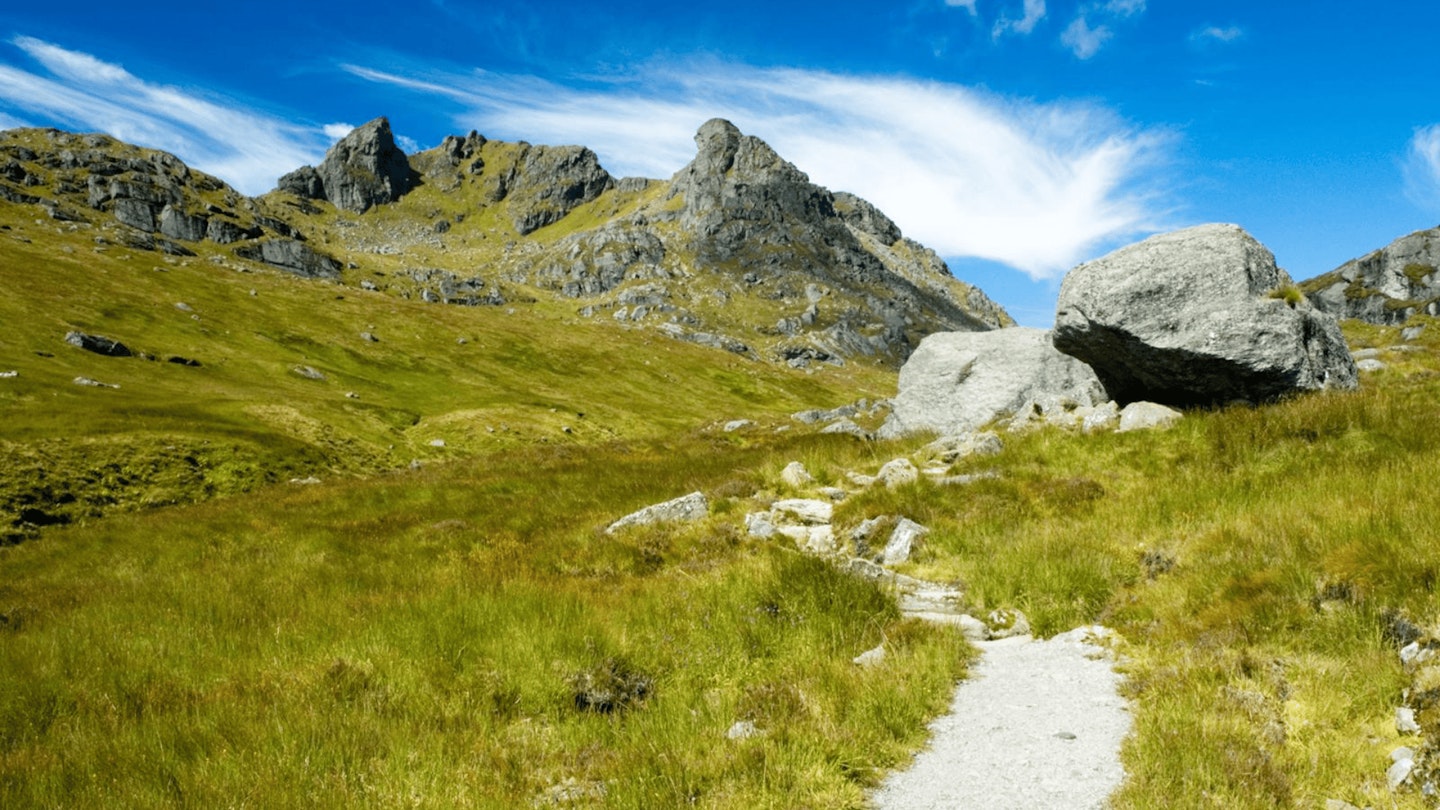
Ben Arthur, better known as The Cobbler, may not be high enough to make Munro status, but it packs in more character than many peaks with far more metres. The highlight is its bizarrely stacked summit which, to be honest, does require a touch of scrambling to reach.
But the bulk of the mountain is pure walker’s territory and with views down Loch Long, over Loch Lomond and to the mountains beyond, the rewards for walking it are huge.
Contender No. 6: The Ring of Steall

When the highest peak in the country is next door, it takes something special to draw boots away from it. The Ring of Steall has no worries there.
Looping up over the Mamores from Glen Nevis via Steall Falls’ wire bridge, this epic circular bags four Munros and the Devil’s Ridge before it’s done. And you’ll have views of Ben Nevis as you walk it. Yes, it takes something special alright, but that’s exactly what the Ring of Steall is – extraordinarily special.
About the author
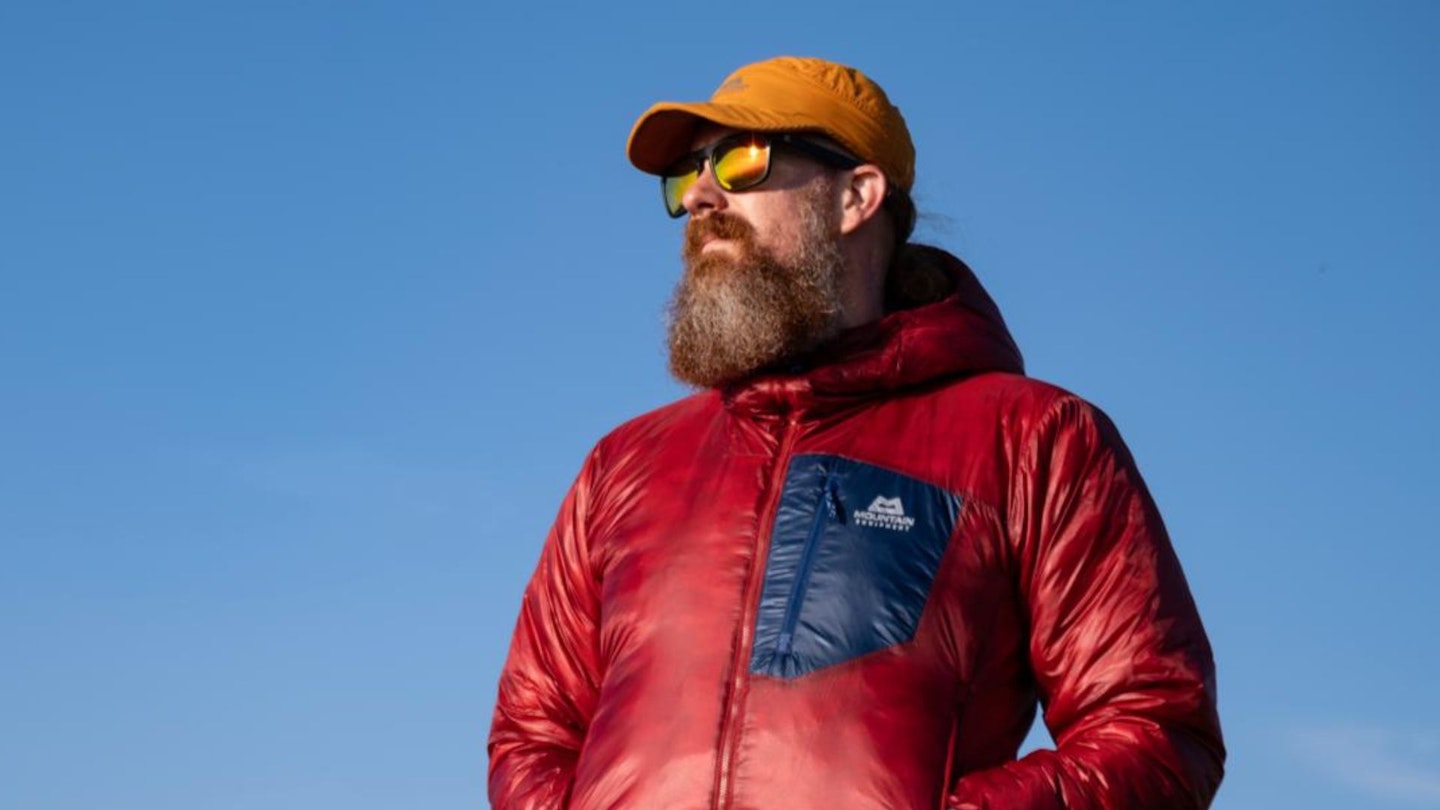
Ben Weeks has been with Trail for over 10 years and is our main point of contact for all gear reviews. As well as being a hugely talented writer and photographer, Ben is also a qualified Mountain Leader and Climbing Instructor.
Along with walking, scrambling and wild camping, he loves gnarly Scottish winter routes so is a master at putting cold weather kit through its paces. Ben’s also the face of our Instagram and YouTube video reviews – the more we think about it, we’d be lost without him!
